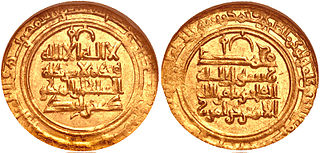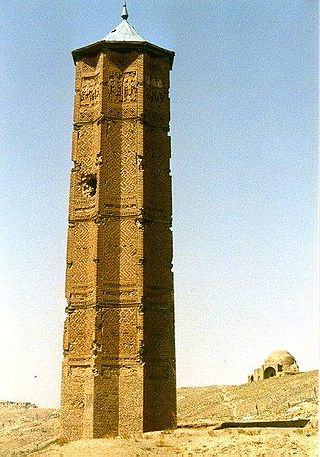Abūʾl-Fazl Muḥammad ibn Ḥusayn Bayhaqī, better known as Abu'l-Fazl Bayhaqi, was a secretary, historian and author.

Abu'l-Hasan Ali ibn Julugh Farrukhi Sistani, better known as Farrukhi Sistani was one of the most prominent Persian court poets in the history of Persian literature. Initially serving a dehqan in Sistan and the Muhtajids in Chaghaniyan, Farrukhi entered the service of the Ghaznavids in 1017, where he became the panegyrist of its rulers, Mahmud and Mas'ud I, as well as numerous viziers and princes.
Khwarazmshah was an ancient title used regularly by the rulers of the Central Asian region of Khwarazm starting from the Late Antiquity until the advent of the Mongols in the early 13th-century, after which it was used infrequently. There were a total of four families who ruled as Khwarazmshahs—the Afrighids (305–995), Ma'munids (995–1017), the line of Altuntash (1017–1041), and the most prominent ones, the Anushteginids (1097–1231). Like other contemporary Central Asian titles, such as Afshin and Ikhshid, the title of Khwarazmshah is of Iranian origin.

Muhammad of Ghazni was Sultan of the Ghaznavid Empire briefly in 1030, and then later from 1040 to 1041. He ascended the throne upon the death of his father Mahmud in 1030. He was the younger of a set of twins; this circumstance resulted in civil strife. His reign lasted five months before he was overthrown by his twin Ma'sud I, after which he was blinded and imprisoned on the order of Ma'sud I. According to Ferishta, his reign lasted only 50 days. Nine years later he was reinstated for a year before being slain by his nephew Maw'dud after losing a battle in Nangrahar.

Shahāb-ud-Dawla Mawdūd, known as Mawdud of Ghazni, was a sultan of the Ghaznavids from 1041 – 1050. He seized the throne of the sultanate from his uncle, Muhammad of Ghazni, in revenge for the murder of his father, Mas'ud I of Ghazni. His brother Majdud in Lahore did not recognize him as sultan, but his sudden death paved the way for Mawdud to exercise control over the eastern portion of the Ghaznavid Empire.
Abū Alī Hasan ibn Muhammad ibn Abbās, better known as Hasanak the Vizier, also Hasanak Mīkālī, was an Iranian statesman from the Mikalid family, who served as the vizier of the Ghaznavid sultan Mahmud from 1024 to 1030. After having been removed from the vizierate, Hasanak still continued to be an important and influential figure in the Ghaznavid state. However, he later fell out of favor and was executed by hanging during the reign of Mahmud's son Mas'ud I. Hasanak's official charge was infidelity which was a politically motivated charge, and his execution was ordered by the Abbasid caliph of Baghdad.

Masʽud I of Ghazni, known as Amīr-i Shahīd, was sultan of the Ghaznavid Empire from 1030 to 1040. He rose to power by seizing the Ghaznavid throne from his younger twin Mohammad, who had been nominated as the heir upon the death of their father Mahmud of Ghazni. His twin was shortly blinded and imprisoned. However, when much of Masʽud's western domains had been wrested from his control, his troops rebelled against him and reinstated Mohammad to the throne.

Muhammad ibn Rustam Dushmanziyar, also known by his laqab of Ala al-Dawla Muhammad, was a Daylamite military commander who founded in 1008 the short-lived but important independent Kakuyid dynasty in Jibal. He is also known as Pusar-i Kaku, Ibn Kakuyeh, Ibn Kakuya, and Ibn Kaku, which means maternal uncle in the Deylami language, and is related to the Persian word "kaka". Muhammad died in September 1041 after having carved out a powerful kingdom which included western Persia and Jibal. However, these gains were quickly lost under his successors.

Abu Mansur Faramurz, mostly known as Faramurz, was the Kakuyid Emir of Isfahan. He was the eldest son of Muhammad ibn Rustam Dushmanziyar. In 1051, He was defeated by Tughril, sultan of the Seljuk Empire, and became his vassal. Faramurz later died after 1063, probably in the 1070s.
The Mikalid family, also known as the Mikalis, was a prominent Iranian aristocratic family of Khorasan from the 9th century to the 11th century. They were descended from the pre-Islamic nobility of Samarkand.
Abuʾl-Ḥasan al-Qāsim Aḥmad ibn Ḥasan Maymandī was a Persian vizier of the Ghaznavid ruler Mahmud of Ghazni and the latter's son Mas'ud I of Ghazni.
Abu'l-Hasan Ali ibn Ubaydallah Sadiq, commonly known as Ali Daya, was a Tajik commander who served under the early Ghaznavid rulers, but later fell out of favor and was executed.
Abd al-Razzaq Maymandi was a Persian vizier of the Ghaznavid Sultan Maw'dud Ghaznavi and Abd al-Rashid.
Abu'l-Hasan Ali ibn Fadl ibn Ahmad Isfarayini, commonly known as Abu'l-Hasan Isfarayini, was a Persian vizier of the Ghaznavid sultan Mahmud of Ghazni from 998 to 1010.
Alī ibn Īl-Arslān, was a powerful and influential Turkic statesman who served the early Ghaznavid Sultans.
Abu Sahl Muhammad ibn Husayn Zawzani, better known as Abu Sahl Zawzani, was a Persian statesman who served as the chief secretary of the Ghaznavids briefly in 1040, and later from 1041 to an unknown date. Zawzani died in 1054.
Abd al-Hamid ibn Ahmad ibn Abd al-Samad Shirazi, better known as Abd al-Hamid Shirazi, was a Persian vizier of the Ghaznavid Sultan Ibrahim and the latter's son Mas'ud III.
Abu Nasr Mansur ibn Moshkan, better simply known as Abu Nasr Moshkan, was a Persian statesman who served as the head of the Ghaznavid chancery from 1011/2 till his death in 1039/40. His nephew, Tahir ibn Ali ibn Moshkan, known by his title of Thiqat al-Mulk, served as the vizier of Sultan Mas'ud III.

Ghazni is a city in southeastern Afghanistan, which served as the capital of the Ghaznavid Empire from 977 to 1163.







